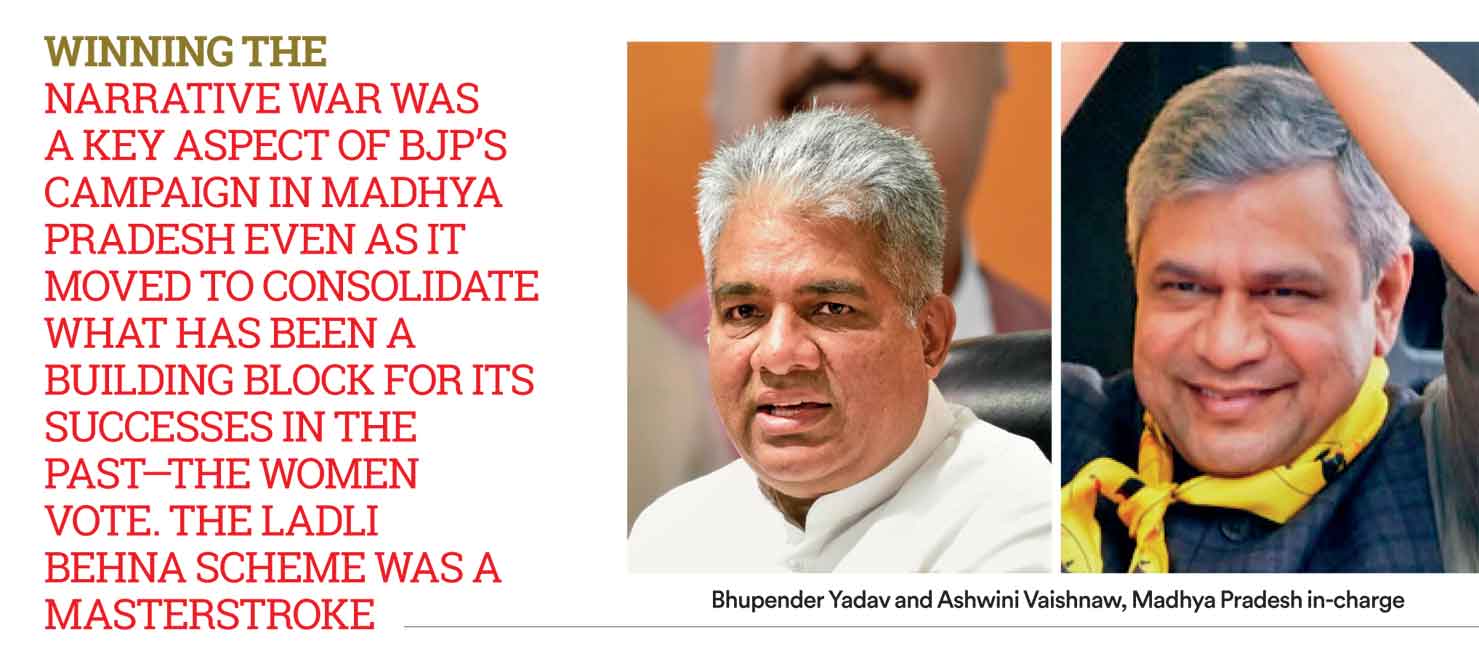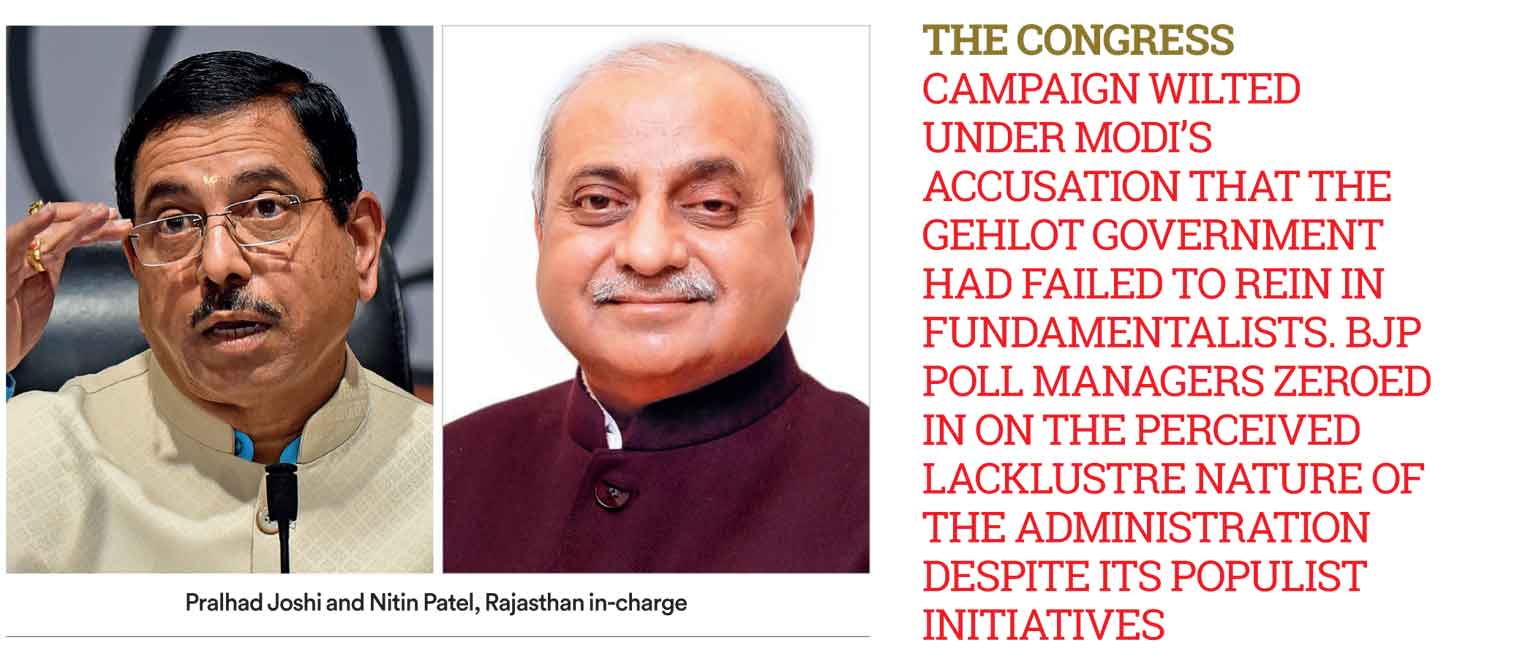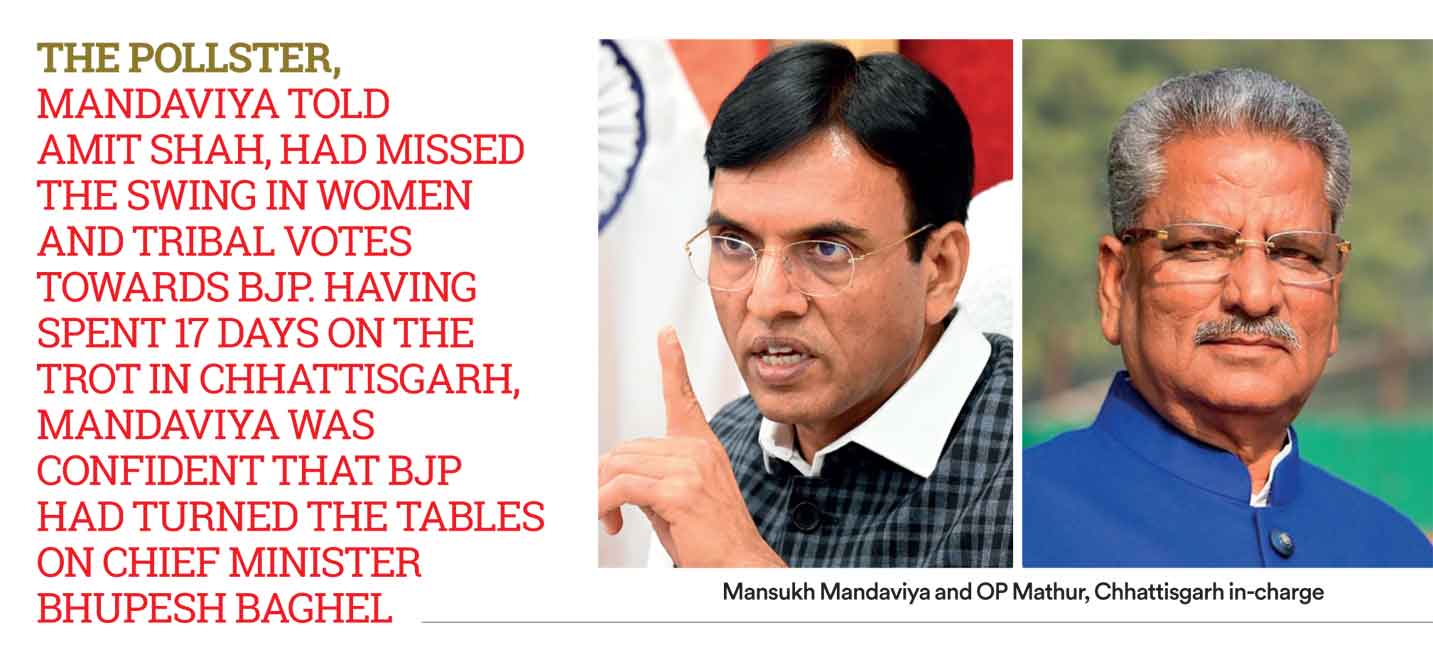The Men and the Machine
Helped by its election apparatus to come back from behind in three heartland states, an energised BJP can now provide a perfect launchpad for Modi’s bid for a third term
 Rajeev Deshpande
Rajeev Deshpande
 Rajeev Deshpande
Rajeev Deshpande
 |
08 Dec, 2023
|
08 Dec, 2023
/wp-content/uploads/2023/12/Themanandmachine1.jpg)
Union Home Minister Amit Shah on the campaign trail in Rajasthan, November 17, 2023 (Photo: AP)
ON THE PHONE with Union Home Minister Amit Shah after a pollster, one with a better track record, predicted a close fight in Chhattisgarh with Congress holding the edge, Health Minister Mansukh Mandaviya asserted that the exit poll had got it wrong. The pollster, Mandaviya told Shah, had missed the swing in women and tribal votes towards the Bharatiya Janata Party (BJP). Having spent 17 days on the trot in Chhattisgarh, not even going home for Deepavali and the Gujarati New Year, Mandaviya was confident that BJP had turned the tables on Chief Minister Bhupesh Baghel, who had cultivated a strongman image and seemed invincible just weeks ago. The results were the proof of the pudding. BJP staged a dramatic comeback, sweeping 14 seats in Surguja in the north and winning eight of 12 seats in Bastar in the south, confirming tribal support for the party. The results were more mixed in the central plains, the rice bowl of the state, but Congress could not undo the damage inflicted in the tribal belts and BJP scored a major upset winning 54 seats in the 90-member Assembly.
Things had looked very different at the start of the campaign with Baghel’s nurturing of paddy farmers, a vice-like grip on the administration, and a large war chest giving Congress an advantage. BJP workers were demoralised and the party hardly received attention from local media outlets. In mid-September, BJP organised two Parivartan (change) Yatras, with one flagged off by Shah in Dantewada. The response to the yatras conducted on foot was encouraging, leading party managers to dig deeper into likely reasons for discontent against Baghel. It appeared that issues such as corruption and unfulfilled promises like non-implementation of an alcohol ban and lack of support for Tendu leaf trade could be fertile ground for a BJP campaign. The party manifesto released in early November promised to procure Tendu leaf at ₹5,500 per bag and offer financial assistance of ₹1,200 a year to married women under a ‘Mahtari Vandan Yojana’. The party topped Congress’ offer on paddy procurement by promising procurement of 21 quintals per acre at ₹3,100 per quintal. BJP did not, however, offer a loan waiver as Congress had done.
Looking to test its manifesto promises, BJP asked party workers to distribute a ‘form’ for the Mahtari Vandan scheme and former Chief Minister Raman Singh, contesting from Rajnandgaon, appealed to women to come forward and ink their support. The response, said BJP leaders, was overwhelming and a rattled Baghel is learnt to have asked district administrations to prevent distribution of the ‘forms’. But when a BJP worker was detained, the party organised a protest by women at the police station, forcing authorities to release the functionary. By the time the campaign wound up, BJP had collected 53 lakh signatures in support of the scheme, bolstering the confidence of party managers that major chinks in Congress’ armour had been exposed. The party also carried out an intense outreach among the paddy farmer constituency—seen to be a bellwether voting segment—and was able to win seats as Congress’ appeal with this section waned. The constituency results map of Chhattisgarh shows a large saffron swathe in the centre of the state with BJP also winning all four seats in Raipur.
BJP WAS IN office in neighbouring Madhya Pradesh where it has struck deep roots. Yet, this time round, there was a sense of fragility about its prospects due to its latest stint in office coming about not from an electoral win but Congress leader Jyotiraditya Scindia and a band of Congress MLAs switching loyalties. Chief Minister Shivraj Singh Chouhan, though an indefatigable campaigner, had been in office since 2005, barring a 15-month interval, and there was concern over likely voter fatigue. BJP in the state has never been free of factionalism and a lengthy tenure bred complacency and a sense of entitlement. Veteran leaders benched by the party made no secret of their unhappiness. But there were positives that could work for the party. The benefits of welfare and pro-farmer schemes were reaching recipients and the incidence of rural distress had clearly declined. Under Chouhan, Madhya Pradesh had emerged as an agricultural powerhouse with the spread of irrigation through canals.
Central Ministers Bhupender Yadav and Ashwini Vaishnaw, named in-charge of BJP affairs in Madhya Pradesh, sought to energise the party machinery by holding detailed deliberations that were inclusive and focused on identifying tasks. The decision of the BJP leadership to ask Union Cabinet ministers, party seniors and MPs to contest the polls dramatically reduced the scope for dissidence and factionalism. The leaders in the fray were under pressure to not only win their own seats but also deliver in their ‘zones’ of influence. Congress sought to attack Chouhan over alleged corruption, drawing from its successful campaign in Karnataka earlier this year where the party claimed that a 40 per cent commission was being extracted by contractors. BJP moved quickly to blunt this charge, counterattacking by pointing to cases involving a close relative of Congress leader and former Chief Minister Kamal Nath. As the party did in other states, BJP concentrated on presenting its campaign under the umbrella slogan of ‘Modi ki Guarantee’ that worked well as a counterpoint to Congress’ populist agenda.

Winning the narrative war was a key aspect of BJP’s campaign in Madhya Pradesh even as it moved to consolidate what has been a building block for its successes in the past—the women vote. It was no surprise that after BJP’s massive victory, winning 163 of 230 seats, an emotional Chouhan emerged from his residence to hail and bow to “ladli behnas (loved sisters)” as women supporters showered him with flower petals. Though Chouhan has advocated pro-women schemes in the past like Ladli Lakshmi that offers financial support for the education of girls from poor families, his decision to announce and implement the Ladli Behna scheme was a masterstroke. It served to refresh the bond between women voters and BJP, and was a crucial decision in the context of how the election turned out. BJP used its organisational reach to ensure the message reached rural voters along with the manifesto promise to prioritise Ladli Behna beneficiaries for a housing scheme. The manifesto also promised to add cooking oil, sugar and pulses at concessional rates for Public Distribution System (PDS) beneficiaries, another important commitment as the party had noted discontent over inflation among daily wagers and farm labourers.
Elections in Rajasthan often run close and while a little over 2 per cent of votes separates BJP and Congress, the saffron party won decisively in the Mewar, Marwar and Hadoti regions while reversing the 2018 election trend in the eastern part of the state. The strategy was simple enough with BJP concentrating on the Ashok Gehlot government’s failures and strongly presenting itself as the viable alternative, thereby reducing the space for smaller parties. Though Gehlot and his estranged deputy Sachin Pilot rebutted Prime Minister Narendra Modi’s charge that the latter was being victimised for his father Rajesh Pilot’s “revolt” against the Congress leadership, the denials were ineffective. Pilot’s caste vote of Gujjars, which had favoured Congress in 2018, moved to BJP, dealing a deadly blow to Congress’ prospects. BJP launched its campaign on multiple fronts, stating that the government was inefficient and failed to contain extremism. Former Gujarat Deputy Chief Minister Nitin Patel, BJP co-in-charge of the state, said radical elements with a “pro-Pakistan” mindset had flourished under the Congress regime. Though incidents like the “unity march” organised by the banned Popular Front of India (PFI) in February 2022 to celebrate its foundation day in Kota or the beheading of Kanhaiya Lal, a tailor in Udaipur in June the same year for supporting former BJP spokesperson Nupur Sharma, may not have always been in discussion, these were very much part of a strong undercurrent. The Congress campaign wilted under Modi’s sharply worded accusation that the Gehlot government succumbed in the face of fundamentalist organisations and failed to rein them in.

BJP poll managers zeroed in on the perceived lacklustre nature of the administration despite populist initiatives like free smartphones for women as per income criteria and eligibility under the Chiranjeevi insurance programme, the cover of which was expanded to ₹50 lakh in the Congress manifesto. BJP questioned the promised expansion of the Chiranjeevi programme, asking the state government to reveal how many people had accessed insurance above ₹5 lakh. BJP said the number was very small while, on the other hand, more than a crore people had received the benefits of the Centre’s Ayushman Bharat scheme providing a health cover of up to ₹5 lakh. The distribution of free mobiles was attractive but the move did not pay the expected dividends in light of the distracting infighting in Congress and slack functioning of government departments under various ministers.
BJP’s campaigns in the poll-bound states were run along distinct lines but Central observers and state leaders provided detailed assessments to the party leadership. Modi was the face of the BJP campaign even as state leaders like Chouhan in Madhya Pradesh played their part. Shah was an important node in the BJP battle plan as he reviewed feedback and evaluated progress of the party campaign in tandem with party functionaries. He also addressed meetings in all poll-bound states whereby he offered a careful response to Congress’ vociferous advocacy for a caste enumeration, saying this was not ruled out but would need careful study. “We don’t practise politics of appeasement for votes. We will take an appropriate decision (on caste census) after holding discussions. BJP never opposed a caste census but decisions have to be taken after giving it a lot of thought,” Shah told the media in Raipur. It was an important intervention that did not reject the call for a caste census that gained stridency after Bihar Chief Minister Nitish Kumar released a caste count for the state. The home minister also spent time in Telangana as polls were closing in a bid to provide a fillip to the party’s fortunes which had declined after appearing to be promising till a few months ago.

BJP LEADERS WILL rue missed chances in Telangana after the party’s performance in the 2020 Greater Hyderabad municipal election (it won 48 seats to the Bharat Rashtra Samithi’s (then TRS) 56). The result had marked the continued absence of Congress from the state’s political scene and gave TRS plenty to think about. There is a view in BJP that the party could have been in the reckoning for 30-odd seats and that might have been sufficient to keep Congress out of office. It does seem that BJP could not counter the impression that it was not doing enough to take on BRS, with questions raised about the lack of action against members of the ruling K Chandrashekar Rao (KCR) clan in the Delhi excise scam case. The internal dynamics of the party remained unsettled with the popular Bandi Sanjay Kumar stepping down as state party chief in July 2023, apparently due to an inability to pull along with others. The decision continues to be debated but it is clear that there was no effective replacement and BJP’s graph dipped. Modi’s outreach to the Madiga Scheduled Caste (SC) community over the demand for sub-categorisation of quotas did help to boost the party’s votes but may have been too late. During the campaign, BJP functionaries agreed that the popular mood had soured as far as BRS was concerned, indicating that KCR was on his way out. Congress exploited the vacuum and adroitly grabbed the initiative and won a majority. As BRS’ decline is unlikely to be reversed in the next few months when the Lok Sabha polls will be due, BJP leaders are preparing for what they feel is a direct contest with Congress.
CAMPAIGNS FOR STATE elections sometimes lend themselves to comparison with T20 cricket matches, requiring quick decisions, swift shifts in gear and, of course, an explosive finish. Ahead of polling day in each state, the BJP organisation was primed and ready. Party booth in-charges were asked to mobilise the women vote early so that their votes could be substantially cast by midday. Polling agents were told not to delay reporting of any mala fide practice or irregularity and complaints were immediately despatched to the state election officials, seeking redress. Finally, party agents were instructed not to leave the polling booth without having gathered full details of votes cast with regard to gender and locality. The party’s organisational machinery worked well on the given day although, without a credible campaign, workers would have only been able to do so much. In contrast to the situation in Karnataka where party seniors simply did not pull along and even beneficiaries of the Bommai government’s decisions, such as provision of quota benefits for the influential Gowda community, did not receive the message, BJP was able to communicate effectively in the current round of state polls. Even in Mizoram, where BJP does not have much of a presence, Defence Minister Rajnath Singh campaigned in seats where the party fancied its chances. BJP won two seats while a relative newcomer, the Zoram People’s Movement (ZPM), got a clear majority. Congress suffered a shock, sliding to one seat while incumbent Chief Minister Zoramthanga lost conclusively.
In 2018, BJP had lost all three heartland states and this had given a boost to the opposition ahead of Lok Sabha polls. The more astute Congress leaders had understood that the national election would be a different ballgame as it would be centred on Modi. BJP did take some quick correctives, such as bringing in a quota for ‘backwards among forwards’, or the economically weaker sections. Upper-caste anger, particularly in Madhya Pradesh, over the Centre’s reversal of a Supreme Court ruling diluting certain aspects of the Scheduled Caste and Scheduled Tribe (Prevention of Atrocities) Act, had led to a backlash against BJP. In Rajasthan, the controversy over the film Padmaavat, opposed by the Karni Sena (a Rajput outfit), had hurt the party apart from factionalism. In Chhattisgarh, Raman Singh’s administration had come to be seen as being influenced by a coterie. This time round, BJP has got its act together and its poll machinery is in fine fettle, with workers as well as the vote base energised. No election can be taken for granted, but BJP’s electoral dominance provides a springboard for its bid to seek a third term for Modi.
About The Author
MOst Popular
3

/wp-content/uploads/2025/07/Cover-Shubman-Gill-1.jpg)










More Columns
Nimisha Priya’s Fate Hangs In Balance, As Govt Admits It Can’t Do Much Open
Roots of the Raga Abhilasha Ojha
An Erotic Novel Spotlights Perimenopause Nandini Nair